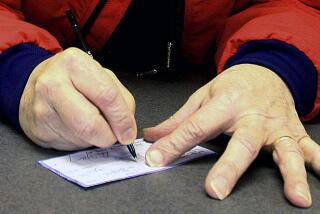Traveler’s Checks’ Pledge Is Step Backward
- Share via
It’s a great competitive coup, American Express’ new offer of hand-delivered replacements for lost or stolen checks. Travelers need only find a phone, call toll-free or collect to one of nine refund centers, and American Express will send out a courier with replacements.
It may be innovative in its field, but this is no advance, if advance implies forward motion. The request is a high-speed telecommunication across the global village; the fulfillment is a local man on foot, wheels, maybe camel, with paper pad and pen in hand. This is backward motion--manual, pedestrian and cursive in the technological age.
But then, the whole product is backward. In a day of electronic transfers, plastic cards and automated tellers, people are still fooling with paper, countersignatures and serial numbers. Even 30 years ago, traveler’s checks were backward. “When we first began offering our card in 1958,” says Thomas Cash, senior vice president of worldwide marketing for American Express, “people thought we were spelling the end of the traveler’s check. There would be no more traveler’s check sales.”
Certainly traveler’s checks are a “mature” product: American Express’ hand delivery is hailed as an innovation partly because it’s the first innovation in years. Some of the other basic benefits of traveler’s checks are weakened and unreliable: Once as good as cash, and good everywhere, traveler’s checks are now harder to change into money. Many banks, here and abroad, charge stiff fees to cash them or refuse to cash them at all for non-customers. “It was a pain when I went to Europe,” says one recent traveler. “Lines at banks were long, hours were short, hotels charged a lot. I was always looking for a place to cash traveler’s checks.”
The industry consensus is that the decade’s sales were fairly flat. Even American Express, the industry leader, saw its dollar volume of checks increase only 50% (from $16 billion to $24 billion) between 1985 and 1989, and less than 3% from ’88 to ’89. “It’s not a growth market,” says Leonard Berry, retail and marketing professor at Texas A&M;, “but it’s a lucrative product.”
The real growth has been in plastic cards. Although the total dollar volume on traveler’s checks last year was an estimated $50 billion worldwide, Visa and MasterCard credit cards were used to charge up more than $200 billion in this country alone.
Traveling on plastic has advantages. Consumers don’t need to carry those records of serial numbers and date and place of purchase, they get monthly records of purchases and they can stop payment on a purchase.
Cards can even be used to get cash, although where and how, and at what cost, is complicated. MasterCard and Visa system cards offer cash advances against their lines of credit at other member institutions and at certain ATM machines, even abroad. This is expensive cash, incurring finance charges from the date of withdrawal, plus transaction fees.
Then there are ATM cards, which have dramatically cut the use of traveler’s checks. They are moving abroad on the growing Cirrus and Plus networks and are soon expected--familiar prediction--to kill off traveler’s checks entirely. This is easy money and cheaper than credit card advances: It’s taken from the customer’s checking account, enjoys a favorable “interbank” exchange rate and is subject, at most, to a nominal transaction fee.
But these cards, obvious advances over traveler’s checks, have limitations. ATMs are just plain limited: “Internationally, ATM networks are still in their infancy,” says David Robertson, vice president of marketing for the Nilson Report, a newsletter covering the credit and debit card industry. “The Visa and MasterCard networks are further along because they’re more lucrative.”
Acceptance even of charge cards is unpredictable. American Express is the business traveler’s card of preference, usually welcomed for high-ticket expenditures at airlines, hotels, big restaurants--but not at small merchants. Bank cards tend to serve shopping vacationers better, signing up more retail merchants: Sixty percent of MasterCard’s dollar volume in the United States, for example, comes from retailers.
Cards are least secure in the traveler’s psyche. No one is sure his particular charge card will be accepted. Many people are fearful about the location and function of ATM machines in strange places. “Even if they find the right kind of machine,” says a traveler’s check advocate, “what if their card gets stuck in it?”
Hence the lingering need for traveler’s checks--their very paper, says Berry, is “tangible and very comfortable to people uncomfortable with new technology.” Some people, says Keith Kendrick, senior vice president of marketing for MasterCard International, just “feel more secure with a negotiable currency.” Or whatever is most easily turned into real currency.
Maybe people just want better traveler’s checks. Maybe they want better cards. Maybe they want both--the cards that are promoted as an all-purpose, universally accepted payment product, and the good old pedestrian traveler’s checks that are necessary because the promotion isn’t true.
It may never be true, whatever the new technology. “Twenty years ago,” says Cash, “the paperless society was the rage; it was going to be the end of checks. But people write more checks now than ever.”
More to Read
Sign up for The Wild
We’ll help you find the best places to hike, bike and run, as well as the perfect silent spots for meditation and yoga.
You may occasionally receive promotional content from the Los Angeles Times.






